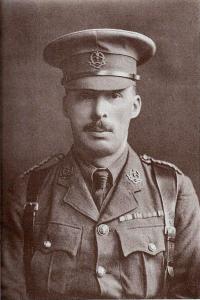
|

|
| Lieutenant Colonel George Henry NEALE | |
|
3rd Battalion Middlesex Regiment Date of birth: 31st January 1869 Date of death: 28th September 1915 Killed in action aged 46 Commemorated on the Loos Memorial Panels 99 to 101 |

|
| George Henry Neale was born at Reigate Hill, Reigate in Surrey on the 31st of January 1869 the son of Sisson Watts Neale, a brewer, and Mary Ann (nee Chambers) Neale of 17 High Street, Reigate. He was educated at Lancing College where he was in Seconds House from September 1883 to July 1888. He was a member of the Cricket XI in 1887 and 1888; he was an excellent batsman averaging 14.50 and 25.50 in the years he played for the 1st XI. He was appointed as a Prefect in 1887. He was commissioned as a 2nd Lieutenant in the Queen’s (Royal West Surrey) Regiment from the 3rd Battalion King’s Own Yorkshire Light Infantry on the 17th of January 1891. He was promoted to Lieutenant on the 21st of April 1897 and to Captain on the 17th of December 1898. He saw action in the Niger Soudan Expedition in 1896/7 where he was present at the expeditions to Egbon, Bida and Ilorin (medal and clasp) and where he was in command of No 6 Company, Royal Niger Constabulary to whom he had been seconded in November 1896.He served in the Tirah Expedition of 1897-1898 (medal and two clasps), Frontier of India 1897-1898 (medal amd two clasps) Waziristan 1902 and Tibet 1903 to 1904 where he served as Transport Officer, was mentioned in despatches and was awarded the campaign medal. He continued to play cricket when he was in the army and particularly when he was based in India. At Peshwar in 1903 he made 55 and 124 not out for Peshwar versus Oxford University Authentics. The following month, in a match between the Queen’s Regiment and the Gordon Highlanders on the same ground, he scored 267 from a total of 607 carrying his bat. He was a member of the MCC from 1902 and played one match for them against London County in May 1902 in which he was dismissed without scoring in either innings. He was promoted to Major on the 17th of June 1911. At the outbreak of war his battalion was in India and they sailed home arriving at Mornhill Camp in Winchester on Christmas Eve. After receiving drafts from other battalions and re-equipping they sailed from Southampton at 4.30pm on the 28th of January 1915 arriving off Le Havre at 3am, although it was 2pm before they came ashore when they moved north to Ypres. They saw action during the Second Battle of Ypres where George Neale commanded B and D Companies. During the fighting the officer commanding, Lieutenant Colonel Ernest William Rokeby Stephenson, was mortally wounded on the 23rd of April and Major Neale assumed command of the battalion. They also saw heavy fighting at the Battle of the Frezenberg Ridge where they suffered a large number of casualties. He was promoted to Lieutenant Colonel in May 1915 At 2am on the morning of the 28th of September 1915 the battalion moved forward to continue the British attack, which had started three days earlier, as part of the Battle of Loos. They were to support a battalion of the East Kent Regiment who were detailed to attack the German positions known as the Dump and Fosse 8. Due to overcrowding in the front trenches the attack was delayed until 9.30am when the East Kents went over following an artillery bombardment on the German front line. While the East Kents (Buffs) moved across no man's land in the open the Middlesex men moved along South Face Trench and into Dump Trench, launching a bombing attack against the left of the German line. Although they made good progress initially, their supply of bombs gave out and urgent messages were sent back for more. While this was being done the Germans counterattacked and soon the Middlesex began taking heavy casualties. Realising his men were in great danger in the narrow, congested trench, Neale ordered them to slowly withdraw. By now they were under heavy machine gun fire in enfilade and any man who showed himself above the parapet was soon cut down and at about this time George Neale was killed. The survivors managed to make good their withdrawal. He was mentioned in dispatches in the London Gazette of the 1st of January 1916. He was married to Agatha Augusta Downie (nee Smail); they lived at 57 The Pryors, Hampstead in London NW3. She applied for his medals in March 1921. |
|
| Seconds House |
Back